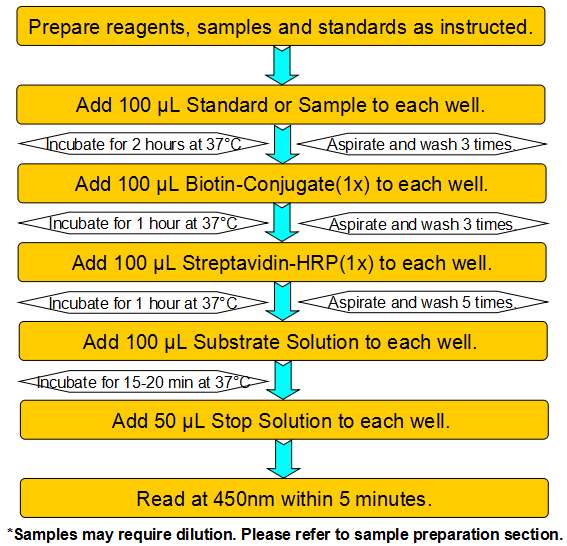Product Details
| Species Reactivity |
Human (Homo sapiens) |
| UniProt |
N/A |
| Abbreviation |
ANG-2 |
| Alternative Names |
Angiotensin II ;AngII |
| Range |
Request Information |
| Sensitivity |
Request Information |
| Sample Type |
Serum, Plasma, Other biological fluids |
| Detection Method |
Sandwich |
| Analysis Method |
Quantitive |
| Assay Duration |
1-4.5h |
| Sample Volume |
1-200 μL |
| Detection Wavelengt |
450 nm |
Test principle
This assay employs a two-site sandwich ELISA to quantitate ANG-2 in samples. An antibody specific for ANG-2 has been pre-coated onto a microplate. Standards and samples are pipetted into the wells and any ANG-2 present is bound by the immobilized antibody. After removing any unbound substances, a biotin-conjugated antibody specific for ANG-2 is added to the wells. After washing, Streptavidin conjugated Horseradish Peroxidase (HRP) is added to the wells. Following a wash to remove any unbound avidin-enzyme reagent, a substrate solution is added to the wells and color develops in proportion to the amount of ANG-2 bound in the initial step. The color development is stopped and the intensity of the color is measured.
Product Overview
Angiogenin (Ang) is a potent inducer of neovascularization. Point mutations in human Ang have been linked to cancer progression and two neurodegenerative diseases: amyotrophic lateral sclerosis and Parkinson's disease. Intensive structural and functional analyses of Ang have been paramount in assigning functions to this novel homologue of bovine pancreatic RNase A. However, inhibitor-binding studies with crystalline Ang have been hampered as a result of the inaccessibility of the active site. Experiments with the murine homologues of Ang have not only overcome the obvious practical limitations encountered when studying the role of a human protein in healthy individuals, but also the crystal structures of murine angiogenins have revealed themselves to have greater potential for the visualization of small-molecule inhibitor binding at the active site.
Components
Reagents |
Quantity |
Reagents |
Quantity |
Assay plate (96 Wells) |
1 |
Instruction manual |
1 |
Standard (lyophilized) |
2 |
Sample Diluent |
1 x 20 mL |
Biotin-Conjugate (concentrate 100 x) |
1 x 120 μL |
Biotin-Conjugate Diluent |
1 x 12 mL |
Streptavidin-HRP (concentrate 100 x) |
1 x 120 μL |
Streptavidin-HRP Diluent |
1 x 12 mL |
Wash Buffer (concentrate 25 x) |
1 x 20 mL |
Substrate Solution |
1 x 10 mL |
Stop Solution |
1 x 6 mL |
Adhesive Films |
4 |
Specificity
This assay has high sensitivity and excellent specificity for detection of Human ANG-2. No significant cross-reactivity or interference between Human ANG-2 and analogues was observed.
Recovery
Matrices listed below were spiked with certain level of recombinant Human ANG-2 and the recovery rates were calculated by comparing the measured value to the expected amount of Human ANG-2 in samples.
Precision
Intra-assay Precision (Precision within an assay)
Three samples of known concentration were tested twenty times on one plate to assess intra-assay precision.
Inter-assay Precision (Precision between assays)
Three samples of known concentration were tested in forty separate assays to assess inter-assay precision.
CV (%) = SD/meanX100
Intra-Assay: CV<8%
Inter-Assay: CV<12%
Linearity
The linearity of the kit was assayed by testing samples spiked with appropriate concentration of Human ANG-2 and their serial dilutions. The results were demonstrated by the percentage of calculated concentration to the expected.
Stability
The stability of ELISA kit is determined by the loss rate of activity. The loss rate of this kit is less than 5% within the expiration date under appropriate storage condition.
The loss rate was determined by accelerated thermal degradation test. Keep the kit at 37°C for 4 and 7 days, and compare O.D.values of the kit kept at 37°C with that of at recommended temperature. (referring from China Biological Products Standard, which was calculated by the Arrhenius equation. For ELISA kit, 4 days storage at 37°C can be considered as 6 months at 2 - 8°C, which means 7 days at 37°C equaling 12 months at 2 - 8°C).
Sample collection and storage
Serum: Use a serum separator tube (SST) and allow samples to clot for two hours at room temperature or overnight at 2 - 8°C before centrifugation for 15 minutes at 1000 × g. Remove serum and assay immediately or aliquot and store samples at ≤ -20°C. Avoid repeated freeze-thaw cycles.
Plasma: Collect plasma using EDTA, or heparin as an anticoagulant. Centrifuge for 15 minutes at 1000 × g at 2 - 8°C within 30 minutes of collection. Assay immediately or aliquot and store samples at ≤ -20°C. Avoid repeated freeze-thaw cycles.
Other biological fluids: Centrifuge samples for 20 minutes at 1000 × g. Remove particulates and assay immediately or store samples in aliquot at -20°C or -80°C. Avoid repeated freeze/thaw cycles.
Kits storage instructions
Store at 2-8°C. Please refer to Instruction Manual.



